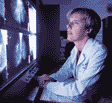 Defining
what digital can do "The question is, is digital any better or even equal to regular film-screen mammography in its ability to detect breast cancer and characterize lesions?" Lindfors said. As it is now, with standard mammography, about 10 percent of screened women are called back to the radiologist for further examination if their mammogram shows a possible abnormality. Fewer than 25 percent of those women will require a biopsy, and when a biopsy is done, only 25 to 30 percent of the time does it actually turn out to be cancer, Lindfors said. As it is now, with standard mammography, about 10 percent of screened women are called back to the radiologist for further examination if their mammogram shows a possible abnormality. Fewer than 25 percent of those women will require a biopsy, and when a biopsy is done, only 25 to 30 percent of the time does it actually turn out to be cancer, Lindfors said. "We are investigating digital mammography to see if we can do a better job characterizing lesions so we can improve that yield," Lindfors said. "We want to determine if we have improved capability with digital for determining whether an abnormality is real and what the risk is that it represents cancer." While it is good news for women to hear that what at first looked like a possible cancer turns out not to be, being called back for further examination is stressful.
Home |
Table of Contents |
To our Readers |
Building on Basics UC Davis Health System | © 2000, 2001, 2002 UC Regents. All rights reserved. |
A leading advocate for women’s health, Karen Lindfors studies digital mammograms for their usefulness as an early cancer detection tool. |

